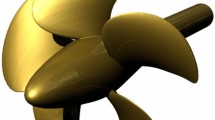Abstract
Computational fluid dynamics (CFD) analyses of propeller boss cap fins (PBCF) were carried out for two different propellers at model and full scale Reynolds numbers with two different inflow conditions. Computations corresponding to the reverse propeller open test (POT) experiment were confirmed to be in a good agreement with the measurement. The results of computations at different conditions have shown that increased Reynolds number and presence of hull wake both positively influence the effects of PBCF. Due to the combined effect of the Reynolds number and the wake, the gain in the propeller efficiency at the full scale condition was found to be significantly larger than that at the model test condition. The detailed investigation of the results suggested that the fin drag becomes smaller and the reduction of the boss drag becomes larger at the full scale condition. However, the predicted gain is still smaller than the values reported in the sea trial and logbook analysis. The remaining gap may be attributed to the difference in the estimated and actual wake distribution or to other factors such as interactions with hull and rudder, surface roughness, unsteadiness and hub vortex cavitation.



























Similar content being viewed by others
Abbreviations
- \( D \) :
-
Propeller diameter
- \( J \) :
-
Advance coefficient
- \( n \) :
-
Rotation speed
- \( K_{\text{T}} \) :
-
Thrust coefficient \( K_{\text{T}} = \frac{\text{Thrust}}{{\rho n^{2} D^{4} }} \)
- \( K_{\text{Q}} \) :
-
Torque coefficient \( K_{\text{Q}} = \frac{\text{Torque}}{{\rho n^{2} D^{5} }} \)
- \( R_{nD} \) :
-
Propeller Reynolds number \( R_{nD} = \frac{{nD^{2} }}{\nu } \)
- \( C_{pn} \) :
-
Pressure coefficient \( C_{pn} = \frac{\text{Pressure}}{{\rho n^{2} D^{2} }} \)
- \( \eta \) :
-
Propeller efficiency \( \eta = \frac{{J \cdot K_{\text{T}} }}{{2\pi K_{\text{Q}} }} \)
- \( V_{0} \) :
-
Velocity of the uniform flow
- \( \rho \) :
-
Density
- \( \nu \) :
-
Kinematic viscosity
References
Ouchi K, Ogura M, Kono Y, Orito H, Shiotsu T, Tamashima M, Koizuka H (1988) A research and development of PBCF (propeller boss cap fins)—improvement of flow from propeller boss. J Soc Nav Archit Jpn 163:66–78 (in Japanese)
Ouchi K, Tamashima M, Kawasaki T, Koizuka H (1989) A research and development of propeller boss cap fins (PBCF): 2nd report: study on propeller slipstream and actual ship performance. J Soc Nav Archit Jpn 165:43–53 (in Japanese)
Ouchi K (1992) Effect and application of propeller boss cap fins (PBCF). J MESJ 27(9):768–778 (in Japanese)
Atlar M, Patience G (1998) An investigation into effective boss cap designs to eliminate propeller hub vortex cavitation. In: Proceedings of practical design of ship and mobile units, Elsevier Science BV, pp 757–769
Nojiri T, Ishii N, Kai H (2011) Energy saving technology of propeller boss cap fins (PBCF) and its evolution. J JIME 46(3):350–358
Hansen HR, Dinham-Peren T, Nojiri T (2011) Model and Full Scale Evaluation of a ‘Propeller Boss Cap Fins’ Device Fitted to an Aframax Tanker. In: Second International Symposium on Marine Propulsors, smp’11, Hamburg, Germany
The Specialist Committee on Unconventional Propulsors (1999) Final Report and Recommendations to the 22nd ITTC, pp 311–346
Kawamura T, Omori T (2009) Reynolds number effect on propeller performance in open water. J Jpn Soc Nav Archit Ocean Eng 10:29–36 (in Japanese)
Kawamura T, Watanabe T, Takekoshi Y, Maeda M, Yamaguchi H (2004) Numerical simulation of cavitating flow around a propeller. J Soc Nav Archit Jpn 195:211–219 (in Japanese)
Rhee SH, Kawamura T, Li H (2005) Propeller cavitation study using an unstructured grid based Navier-Stokes solver. J Fluids Eng 127:986–994
Kawamura T (2011) Numerical simulation of propulsion and cavitation performance of marine propellers. J JIME 46(3):359–365
Hsin C-Y, Lin B-H, Chang C-H, Lin C–C (2008) The analysis and design of PBCF by computation. In: Proceedings of the 4th Asia-Pacific workshop on marine hydrodynamics APHydro 2008, Taipei
Yamasaki S (1989) Propeller performance characteristics in ship stern flow field: 1st report: effects of ship wake and flow contraction by propeller. Transact West Jpn Soc Nav Archit 78:101–111 (In Japanese)
Author information
Authors and Affiliations
Corresponding author
About this article
Cite this article
Kawamura, T., Ouchi, K. & Nojiri, T. Model and full scale CFD analysis of propeller boss cap fins (PBCF). J Mar Sci Technol 17, 469–480 (2012). https://doi.org/10.1007/s00773-012-0181-2
Received:
Accepted:
Published:
Issue Date:
DOI: https://doi.org/10.1007/s00773-012-0181-2




